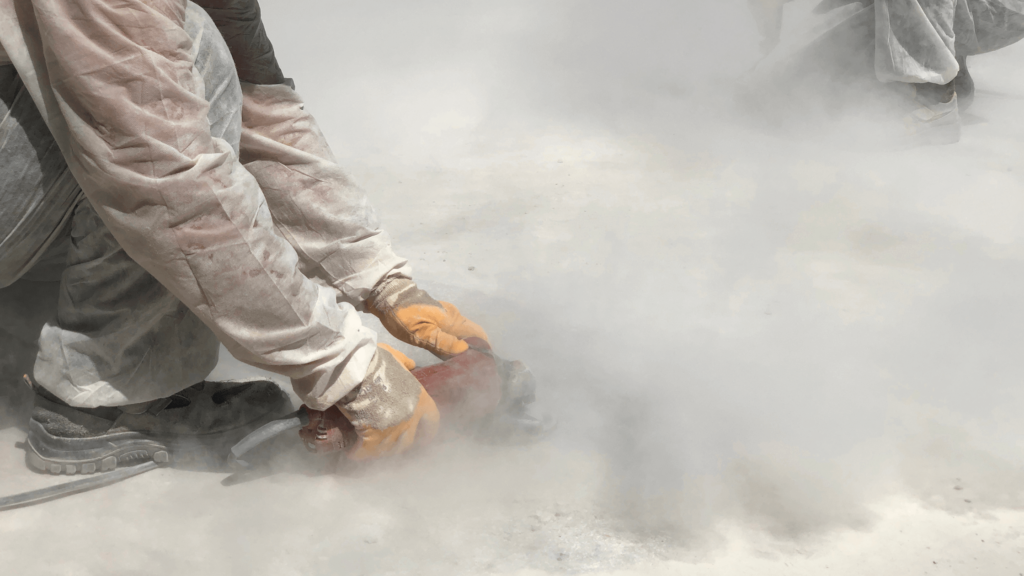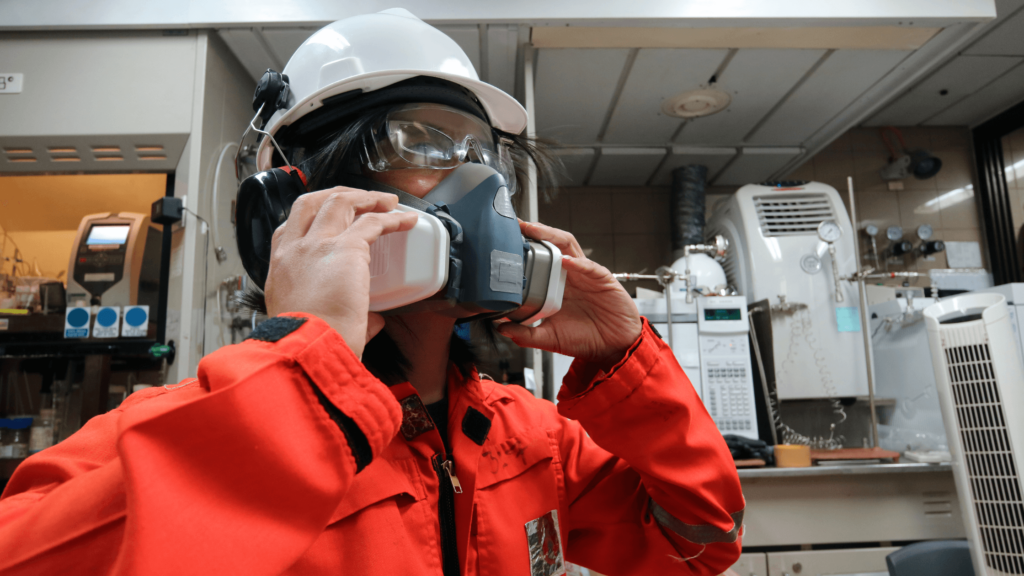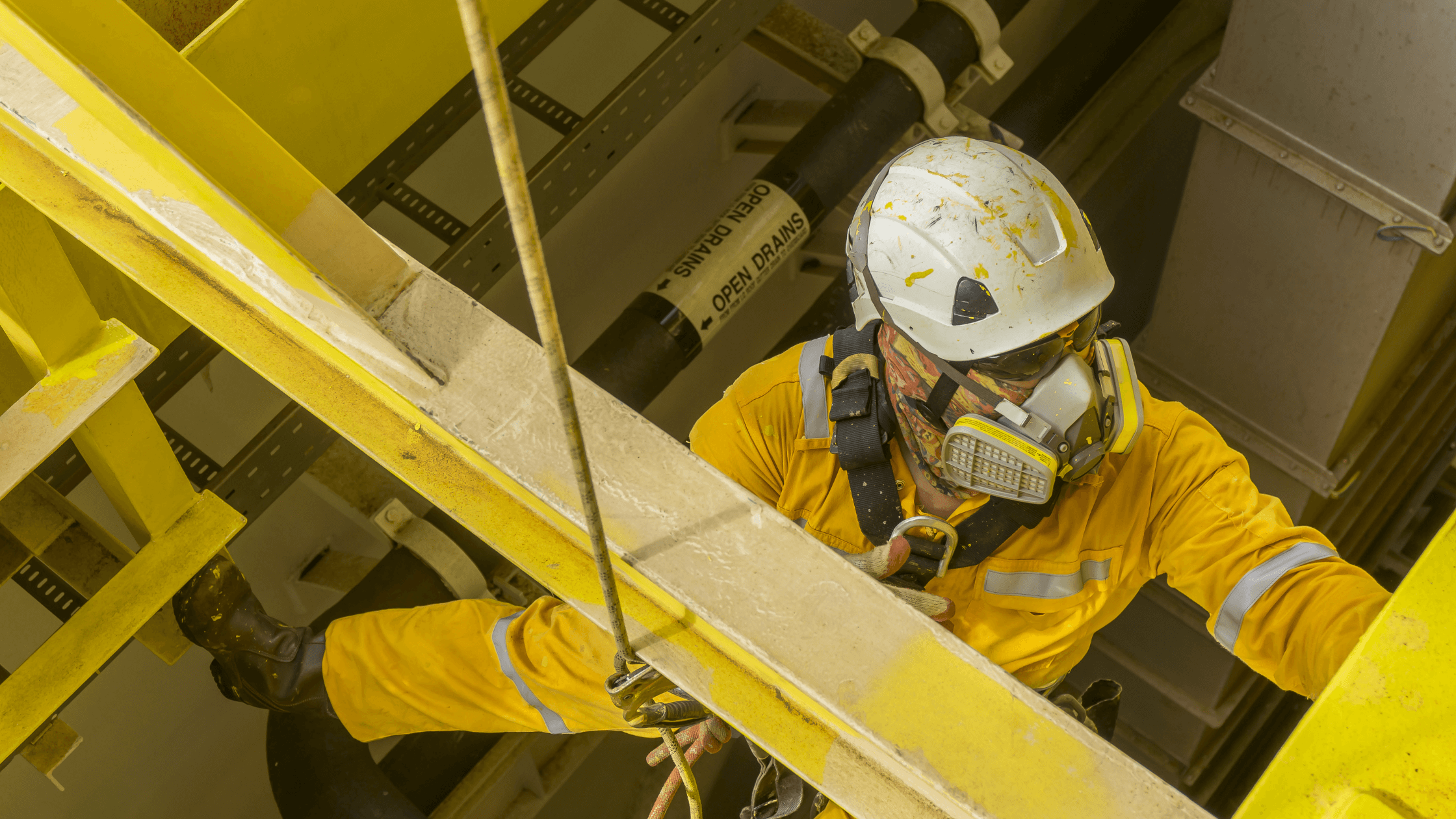In the construction industry, workers are frequently exposed to respiratory hazards such as silica dust, solvent vapors, and asbestos. Without proper protection, long-term exposure can result in conditions like lung cancer, chronic obstructive pulmonary disease (COPD), and silicosis. Using the correct type of respirator for the job ensures workers can breathe safely while staying productive on the job site.
Quick look
- Construction workers are frequently exposed to respiratory hazards like silica dust, solvent vapors, and asbestos, increasing the risk of lung diseases such as silicosis and COPD.
- Respiratory protection includes disposable masks, air-purifying respirators (APRs), and supplied-air systems, each designed to filter out contaminants or provide clean air.
- Employers must assess workplace hazards, provide proper respiratory protection, and ensure workers receive fit testing and training for effective use.
- NIOSH-approved respirators, such as N95 masks, PAPRs, and SCBAs, provide certified protection and help workers stay safe in hazardous environments.
What is respiratory protection?
Respiratory protection refers to devices designed to protect the wearer from inhaling hazardous substances in the workplace. These devices range from simple disposable masks to more complex systems like supplied air respirators or even smart PPE that monitor workers’ health and environmental conditions. The primary function is to filter out contaminants or supply clean air from an external source.
Why respiratory protection is important in construction
Construction environments often contain airborne hazards that can lead to respiratory diseases. Prolonged exposure to substances like silica dust and asbestos increases the risk of developing conditions such as silicosis and lung cancer. Implementing proper respiratory protection measures is essential to prevent these health issues. Employers are responsible for assessing workplace hazards and providing suitable protective equipment. Workers must be diligent in using the provided protection to maintain their health and safety.
Overview of respiratory hazards

Construction sites are rife with materials and processes that release harmful particles and vapors into the air. Activities like cutting, grinding, and welding can generate dust and fumes that are hazardous when inhaled. Recognizing these workplace hazards and understanding their potential impact is the first step toward effective prevention.
- Dust and fumes: Dust and fumes are common byproducts of construction activities. Dust arises from tasks such as cutting or sanding materials, while fumes are generated during welding or soldering. Inhalation of these particles can cause respiratory irritation and long-term health issues.
- Silica dust: Silica dust is produced when materials like concrete and stone are cut or drilled. Inhaling fine silica particles can lead to silicosis, a severe lung disease. To protect against silica dust exposure, use water suppression methods during cutting and wear suitable respiratory protection. Employers should conduct air monitoring to assess silica levels and implement control measures accordingly.
- Solvent vapors: Solvent vapors are released from products like paints and adhesives used in construction. These vapors can cause dizziness, headaches, and long-term neurological damage. Storing solvents in sealed containers when not in use minimizes vapor release.
- Isocyanate vapors: Isocyanates are chemicals found in some paints and foams. Exposure to them can cause respiratory sensitization and asthma. Products containing isocyanates must be used in well-ventilated areas to avoid exposure. Proper storage and handling procedures also reduce the risk of exposure.
- VOCs: Volatile organic compounds (VOCs) are emitted from materials like sealants and adhesives. They can irritate the eyes and nose, leading to difficulty breathing. Selecting low-VOC products minimizes exposure.
- Asbestos: Although asbestos was commonly used in building materials in the past, it still poses severe health risks when disturbed. Inhaling asbestos fibers can cause lung cancer and mesothelioma. Identifying and managing asbestos-containing materials is critical before beginning construction work.
- Mold spores: Mold can grow in damp areas of construction sites, releasing spores into the air. Inhalation of mold spores can cause allergic reactions and respiratory issues. Controlling moisture and promptly addressing water damage prevents mold growth.
- Welding fumes: Welding processes generate fumes containing various metals and gases. Inhaling welding fumes can lead to respiratory problems and metal fume fever. Using local exhaust ventilation captures fumes at the source.
- Diesel exhaust: Diesel-powered equipment emits exhaust containing harmful particles and gases. Prolonged exposure to diesel exhaust increases the risk of lung diseases. Using cleaner fuel alternatives and maintaining equipment reduces emissions.
- Ammonia and chlorine fumes: Some construction processes use ammonia and chlorine, which can release irritating fumes. Inhalation can cause respiratory distress and damage to the lungs. Proper storage and use of these chemicals in well-ventilated areas minimize exposure.
- Carbon monoxide: Carbon monoxide is a colorless, odorless gas produced by combustion engines. Inhalation can lead to poisoning and is potentially fatal. Using carbon monoxide detectors in enclosed areas where engines operate is vital to staying safe.
Types of respiratory protection for construction workers
Selecting the right respiratory protection depends on the specific hazards present. Various types of equipment are available to address different risks. Understanding the functions and limitations of each type ensures effective protection.
Supplied air respirator
Supplied air respirators provide clean air from an external source, such as a compressor or compressed air cylinder. They are suitable for environments with high contaminant levels or where the air is oxygen-deficient. These respirators offer a reliable supply of breathable air, ensuring safety in hazardous conditions. However, they require a connection.
Air-purifying respirators
Air-purifying respirators (APRs) use filters or cartridges to remove contaminants from the air before inhalation. They are effective against dust, fumes, vapors, and gases, depending on the type of filter used. Workers must select the correct filter based on the specific hazard present, such as N95 for dust or organic vapor cartridges for chemical fumes. APRs require a proper fit to be effective and should be regularly inspected for wear and tear.
Disposable masks
Disposable masks, such as N95 respirators, provide basic protection against airborne particles like dust and mold spores. They are lightweight, easy to use, and designed for single-use applications. While they help reduce exposure to particulates, they do not protect against gases or vapors. These are a cost-effective option for short-term use in low-risk environments.
Powered air-purifying respirators (PAPRs)
PAPRs use a battery-powered blower to push filtered air into a facepiece or hood. They provide a higher level of protection than standard APRs and reduce breathing resistance, making them more comfortable for extended wear. These respirators are ideal for environments with high levels of airborne contaminants, such as welding operations or asbestos removal. Workers should ensure that filters are replaced as needed and that batteries are fully charged before use. PAPRs can be particularly beneficial for workers who find tight-fitting respirators uncomfortable.
Elastomeric half-mask respirators
Elastomeric half-mask respirators are reusable and feature replaceable filters or cartridges. They provide better protection than disposable masks and are designed for long-term use in environments with airborne hazards. These respirators must be properly fitted to ensure a secure seal, and filters should be selected based on the specific contaminants present. Regular cleaning and maintenance extend the lifespan of these respirators, making them a cost-effective choice for workers exposed to dust, fumes, or chemical vapors.
Elastomeric full-face respirators
Full-face respirators offer the same protection as half-mask versions but provide additional coverage for the eyes and face. This makes them ideal for jobs involving irritating chemicals or airborne debris. The full-face design also helps prevent eye irritation from hazardous fumes or dust. Like half-mask versions, these respirators require proper fit testing and maintenance to ensure effectiveness. They are commonly used in environments with high concentrations of harmful substances.
Self-contained breathing apparatus (SCBA)
SCBAs are used in high-risk environments where air quality is severely compromised, such as confined spaces or areas with toxic gas exposure. These respirators provide an independent supply of clean air, allowing workers to operate safely in oxygen-deficient conditions. SCBAs are bulky and require specialized training to use correctly. They are typically used for emergency situations or hazardous work such as firefighting or chemical spill response.
Escape respirators
Escape respirators are designed for short-term use in emergencies, such as chemical spills or sudden gas leaks. They provide a limited supply of breathable air, allowing workers to exit hazardous areas safely. These respirators are compact, easy to store, and should be readily accessible in high-risk workplaces. While not intended for prolonged use, they are a critical part of emergency preparedness plans.
NIOSH Approved® respirators used in construction
The National Institute for Occupational Safety and Health (NIOSH) certifies respirators that meet strict safety standards for workplace use. NIOSH-approved respirators undergo rigorous testing to ensure they provide effective protection against airborne hazards. Employers should only select respirators with NIOSH certification to ensure workers receive the highest level of protection.
In construction, NIOSH-approved respirators include disposable N95 masks, elastomeric respirators, and PAPRs. These respirators help reduce exposure to dust, fumes, and hazardous vapors commonly found on job sites. Proper training on fit testing, filter selection, and maintenance is essential for maximizing the protection offered by these devices.
How to choose the proper respiratory protection for the job

Selecting the right respirator depends on the type of airborne hazard present and the job conditions. A thorough hazard assessment should be conducted to determine the level of respiratory risk. Factors such as exposure duration, concentration of contaminants, and ventilation should be considered.
Workers exposed to fine dust, such as silica, may need an N95 or P100 respirator, while those handling toxic fumes might require an air-purifying or supplied-air respirator. Fit testing is crucial to ensure a proper seal, and respirators should be inspected regularly for signs of damage. Employers should also provide training on correct usage and maintenance to protect workers.
For employers: How to implement a respiratory protection program
Employers must establish a respiratory protection program to ensure worker safety when airborne hazards pose a risk. The first step is to conduct a thorough hazard assessment to identify potential respiratory dangers, such as silica dust, solvent vapors, and asbestos. Once hazards are identified, the appropriate type of respiratory protection should be selected based on the specific risks present. Employers must also ensure that respirators meet NIOSH standards and are suitable for the level of exposure workers may face.
Proper training is a key component of an effective respiratory protection program. Employees should receive instruction on how to properly wear, adjust, and maintain their respirators and recognize signs of equipment failure. Fit testing must be conducted regularly to confirm that respirators create an effective seal, preventing exposure to harmful particles or vapors. Workers should also be educated on the limitations of their equipment, such as how long a filter remains effective and when a respirator should be replaced. Clear communication about the importance of respiratory protection can help ensure compliance and encourage workers to take their safety seriously.
Ongoing maintenance and air quality monitoring are also essential for a successful program. Employers should establish a schedule for cleaning and replacing respirators and filters, ensuring they remain in proper working condition. Air quality should be tested regularly to confirm that workplace controls, such as ventilation and dust suppression, are effective in minimizing exposure. Compliance with OSHA regulations is mandatory, and employers should stay up to date with industry standards to ensure their program remains effective. By taking these steps, companies can create a safer work environment and protect their employees from long-term respiratory health risks.
Bottom line
Respiratory protection is critical to construction site safety, helping workers avoid serious health risks from airborne hazards. Understanding the types of respiratory threats and selecting the right protection ensures a safer work environment.
Stay informed and protect yourself by learning more about workplace safety—subscribe to Under the Hard Hat’s newsletter and follow us on social media for industry updates and expert tips.




1 comment